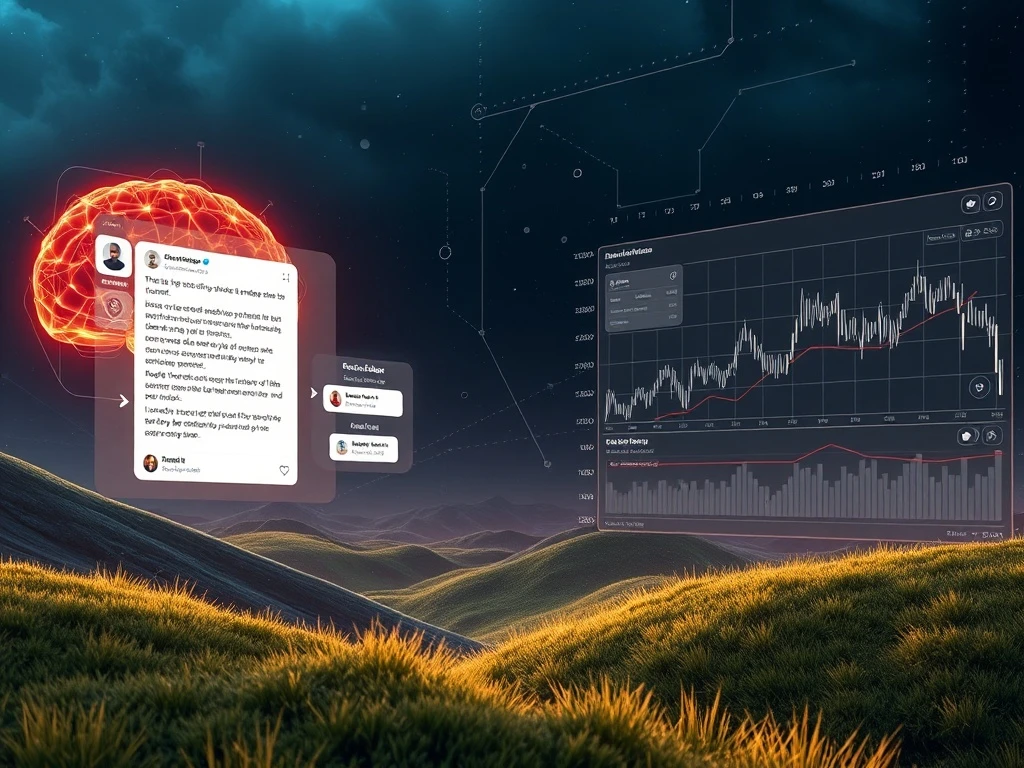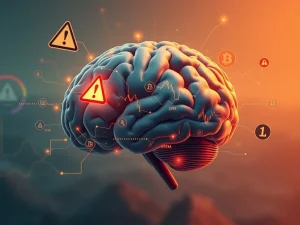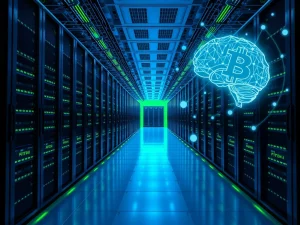ChatGPT and Grok: Unlocking Astounding Crypto Market Sentiment Before Charts

The cryptocurrency market moves at an incredible pace. Traditionally, traders have relied heavily on complex charts to decipher price action. However, a significant shift is now underway. Imagine gaining critical insights into crypto market sentiment and strategic clarity, all through a simple conversation. This revolutionary approach is powered by advanced AI models like ChatGPT and Grok. They are quickly becoming indispensable tools for traders seeking faster, more intuitive understanding of market dynamics, often before even glancing at a chart.
The Evolution of Crypto Analysis: Beyond Traditional Charts
For years, crypto traders navigated volatile markets using technical indicators. Candlesticks, Fibonacci lines, and Bollinger Bands were the standard. These tools, while powerful, often demand deep technical skill and emotional discipline. Many new or even semi-professional traders find charts overwhelming. They present a dense wall of data, conflicting signals, and visual noise. This ‘chart fatigue’ has paved the way for a new era of crypto analysis.
Conversational AI offers an alternative. Instead of meticulously decoding complex graphs, traders now ask natural-language questions. For example, they might ask, “Is this a good time to buy Solana (SOL)?” These AI tools provide insights quickly. They are more intuitive and less intimidating than traditional charting methods. This shift allows traders to grasp market narratives and sentiment without the initial visual overload.
Leveraging AI for Instant Crypto Market Sentiment
AI models excel at synthesizing vast amounts of information rapidly. This capability is particularly valuable for understanding crypto market sentiment. They can process social media discourse, news articles, and on-chain data in moments. This provides a comprehensive overview that would take hours for a human to compile. Here are a few examples of how traders are using AI:
- XRP Sentiment Summary: A prompt like “Summarize current sentiment on XRP using X discourse” fed to Grok yields immediate results. Grok might highlight mixed but cautiously bullish sentiment. It identifies optimism around regulatory catalysts and resilience. However, it also acknowledges lingering skepticism over centralization and past underperformance. This balanced view captures the complex emotional and narrative divides within the XRP community effectively.
- Bitcoin Moving Average Analysis: When asked, “If Bitcoin closes above its 200-day moving average, what tends to follow?” ChatGPT provides historical context. Its response highlights increased buying interest and improved sentiment. It also responsibly notes the risk of false breakouts. This balanced tone is suitable for traders of all experience levels.
- Solana vs. Avalanche User Activity: For a comparison, a trader might prompt, “Compare Solana and Avalanche in terms of user activity this month.” Grok delivers clear, data-backed insights. It often highlights Solana’s dominance in user activity, transaction volume, and decentralized exchange engagement. Conversely, it notes Avalanche’s growth via developer activity but weaker user metrics. The response is concise, informative, and well-contextualized.
These examples illustrate how AI can frame narratives and offer strategic clarity. They provide context that charts alone often cannot.
ChatGPT vs. Grok: Choosing Your AI Trading Assistant
Both ChatGPT and Grok offer powerful capabilities for AI trading, but they have distinct strengths. Understanding these differences helps traders choose the right tool for their specific needs.
ChatGPT (specifically GPT-4o) is an excellent analyst. It excels at breaking down technical indicators, comparing token fundamentals, and simulating trading scenarios. It can even integrate with platforms like TradingView via plugins or API for those who still desire visual analysis. Its training with Reinforcement Learning with Human Feedback (RLHF) ensures safe, instructive dialogue, making it highly reliable for structured inquiries.
Grok, on the other hand, shines with real-time sentiment and cultural signals. Its tight integration with X (formerly Twitter) gives it a native edge. It is perfect for catching fast-moving narratives, meme-aware signals, or early ‘alpha’ from the crypto community. Grok’s ability to process real-time social data makes it an agile companion for understanding immediate market shifts.
To highlight their differences, consider two comparative experiments:
Investment Reasoning: Ethereum (ETH) in August 2025
Prompt: “Give me two reasons to invest in Ethereum (ETH) in August 2025.”
ChatGPT Output:
ChatGPT’s response provides a broader, more accessible rationale. It focuses on:
- ETF Momentum: Highlighting potential exchange-traded fund (ETF) momentum.
- Ecosystem Growth: Emphasizing expansion through Layer-2 solutions and decentralized applications.
This big-picture view highlights Ether’s expanding utility. It is easier for newer investors to grasp. However, it often lacks the numerical specificity found in Grok’s response. This might make it feel less grounded for those seeking hard data.
Grok 3 Output:
Grok 3 offers a more data-driven and technically detailed justification. It highlights:
- Institutional Interest: Citing specific ETF inflow figures (e.g., $528 million in July 2025). This lends credibility and a sense of urgency.
- Technical Upgrades: Referencing the Pectra upgrade and Ethereum Improvement Proposal 7251. These are specific improvements tied to Ethereum’s scalability and validator efficiency.
This caters well to technically literate investors. However, its technical language might overwhelm general audiences. They may be unfamiliar with Ethereum’s internal mechanics.
Intraday Market Analysis: BTC/USD Chart from July 26, 2025
Prompt: “Analyze this intraday price chart of BTC/USD from July 26, 2025. Identify any visible trend shifts or breakout levels. Does the late-session surge suggest bullish momentum, or could it be a short squeeze or reaction to external news? Offer a possible short-term outlook.”
ChatGPT Output:
ChatGPT’s analysis is more fluid and narrative-based. It mentions:
- Range-bound trading: Early in the session.
- Breakout: Around 11:30 UTC, followed by a rally near 12:00.
- Potential causes: External news or a short squeeze.
- Outlook: Cautiously bullish, with a possible pullback.
It is easier to follow but slightly less detailed in technical precision. Support/resistance levels are less precise (e.g., $117,800-$117,900).
Grok 3 Output:
Grok 3 offers a more segmented and data-rich explanation. It breaks down the chart into key sections:
- Trend Shifts: A clear shift around 11:00 UTC, with a breakout above $118,000.
- Surge Cause: Supported by a possible $144-million liquidation event and external triggers like geopolitical tensions.
- Key Levels: Identifies resistance ($118,200-$118,500) and support ($117,600-$117,400) zones.
- Outlook: Interprets the late-session rally as potentially bullish if Bitcoin (BTC) holds key levels.
This structured, technical breakdown helps traders focus on key decision points. It is more precise and offers actionable insights for immediate AI trading decisions.
The key takeaway from these comparisons is clear: different AIs serve different trading needs. For fundamentals and structured logic, GPT-4o is a reliable analyst. For sentiment and speed, Grok is your plugged-in, socially attuned trading companion. This nuanced understanding enhances overall crypto analysis capabilities.
Will AI Completely Replace Charts for Crypto Analysis?
Not entirely. Charts remain a foundational tool, especially for tactical execution. Day traders, swing traders, and quant systems still rely on real-time volume, indicators, and price structure. However, AI is rapidly taking over the cognitive layer of trading. It addresses the “why” behind the “what.” Charts show what is happening. Models like ChatGPT and Grok explain why it’s happening. They digest macro news, on-chain flows, community sentiment, and historical context within seconds.
These AI tools are increasingly used for narrative framing, scenario simulation, and filtering signals from noise. Charts were never designed to fill these roles. So, while candlesticks and other indicators will not disappear, they are no longer the sole source of insight. More often, traders now turn to AI first for clarity, direction, and speed. They then confirm their findings with the chart. This integration creates a more robust and efficient AI trading strategy.
If you have recently asked an AI model about a coin before opening a chart, you are certainly not alone. The move from visual to conversational analysis is well underway. This is especially true among part-time traders and mobile-first users. They prefer direct answers over complex dashboards. Charts are not going away. Their role is simply changing. They are no longer always the starting point, but rather the next layer of verification. In a space where speed matters and clarity is king, AI is becoming the first place traders go to ask:
- What is driving this move?
- What happened last time this occurred?
- What should I watch next?
Because sometimes, the smartest chart is the one that talks back.
Why AI Isn’t a Substitute for Your Crypto Trading Strategy
While AI models offer unparalleled speed and clarity, they are not infallible. Their outputs depend heavily on training data, recent content, and prompt quality. They do not “see” live order books or price movement in real time. They may also miss nuance in complex macro events. Overreliance can lead to false confidence. This is especially true if used without cross-checking with charts or news. Traders should treat AI as a thinking assistant, not a trading oracle. Just as charts can mislead without context, so can AI without verification. The best insights come when human judgment and machine reasoning work together. They should never operate in isolation. This integrated approach ensures a more informed and resilient AI trading strategy.
This article does not contain investment advice or recommendations. Every investment and trading move involves risk, and readers should conduct their own research when making a decision.
Editor’s Choice 13 wallets made over $24M profit dumping the YZY token, data shows Bitcoin analysts point to ‘manipulation’ as BTC price falls to 17-day low Can privacy survive in US crypto policy after Roman Storm’s conviction? US Commerce official buys Bitcoin as Trump tariffs shake markets Age verification has made a colossal misstep, and blockchain needs to get involved Advertise with us









